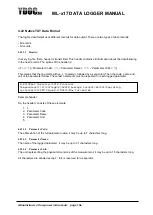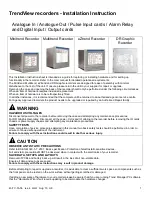
ML-x17 DATA LOGGER MANUAL
Manufacturers of low power instruments
page 120
4.47 Input-drivers
Input-drivers obtain data from sensors. Various sorts of sensors can be connected to the data logger. When
a sensor needs a
“warm-up time” the power output switch can be used to power the sensor before the
measurement is taken. The maximum time of a power delay is 5 minutes
Note:
The Power Switch output is consuming a lot of power, so try to minimize this. Consult the manual of the
sensor for warm up times. A warm up time of 5 minutes is possible and can be used in rare situations, but
the battery-life will be shortened enormously. In such rare cases, consult your local YDOC-supplier for a
calculation of battery-life, before exploiting your data logger.
4.47.1 Analog sensors
The
ML-x17
(except the DS edition) is provided with 5 factory-calibrated analog inputs with 12 bit ADC
resolution.
Input
Range
Accuracy
Impedance
1
4 .. 20mA
<0.1% FS
150 Ohm
2
4 .. 20mA
<0.1% FS
150 Ohm
3
0 .. 10V
<0.1% FS
32 k Ohm
4
0 .. 10V
<0.1% FS
32 k Ohm
5
Potentiometer (0..100%)
or as 0..3300mV input
<0.1% FS
500 k Ohm
4.47.2 Digital Pulse Sensor
Digital Pulse sensors like for instance rain gauges are based upon the “reed contact” principle. The rain
gauge has an internal bucket with a very precise volume. It is constructed to tip over when it reaches a
specified amount of water. The water is drained and while the bucked was turning, a magnet triggered a
magnetic switch, a so called “reed contact” So, the rain gauge itself works like a passive switch. The data
logger has a special input to trigger on these events. Even when the data logger is sleeping, the event of a
tipping bucked is never missed
. The data logger uses a so called “interrupt-input” to make this possible. To
connect a rain-gauge, use this interrupt input and connect the other site
of the rain gauge to the 3V6 output.
Note:
The digital input offers the most energy-friendly measurements available. This is because the data logger
is allowed to sleep most of the time, and only capture the events of the digital interrupt (e.g. the tipping
bucket of a rain gauge). In the situation where only one digital sensor is used, the battery is probably going
to last much longer than any other measurement. For safety-reasons a user can include some internal
measurements in the configuration, to allow monitoring of the performance of the system.
4.47.2.1
Example configuration Rain Measurement
Here an example is shown for a tipping Bucket Rain Gauge, and how to set it up in the data logger.
The Rain-
gauge should be connected to the “Digital input”
Underneath the menu for this input is shown.















































